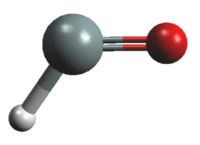Oxosilyl, silaformyl, X 2A'
 | |
|---|---|
| Species tag | 045514 |
| Version | 1* |
| Date of Entry | Dec. 2012 |
| Contributor | H. S. P. Müller |
|
The experimental lines are from | |
| Lines Listed | 2254 |
| Frequency / GHz | < 1620 |
| Max. J | 43 |
| log STR0 | -6.0 |
| log STR1 | -4.0 |
| Isotope Corr. | -0.0363 |
| Egy / (cm–1) | 0.0 |
| µa / D | 3.386 |
| µb / D | (0.039) |
| µc / D | |
| A / MHz | 312108. |
| B / MHz | 19884.44 |
| C / MHz | 18607.98 |
| Q(300.0) | 10412.2716 |
| Q(225.0) | 6749.9798 |
| Q(150.0) | 3668.3768 |
| Q(75.00) | 1296.5520 |
| Q(37.50) | 459.6302 |
| Q(18.75) | 163.6526 |
| Q(9.375) | 58.9800 |
| Q(5.000) | 25.2519 |
| Q(2.725) | 13.2588 |
| detected in ISM/CSM | no |